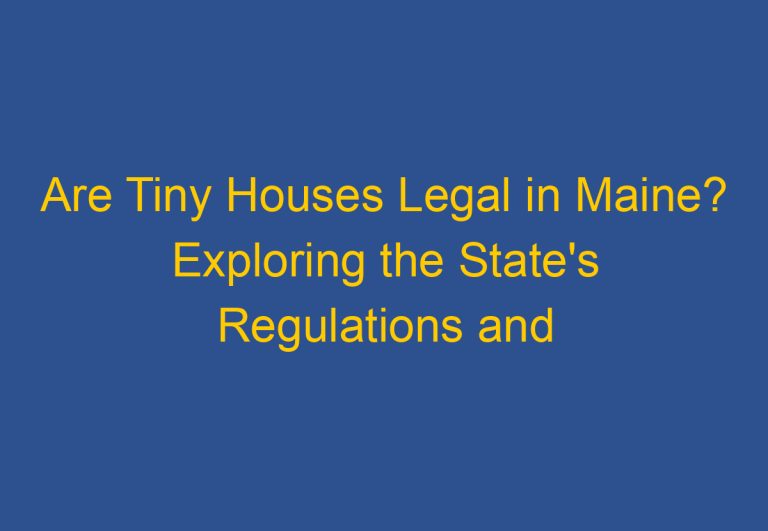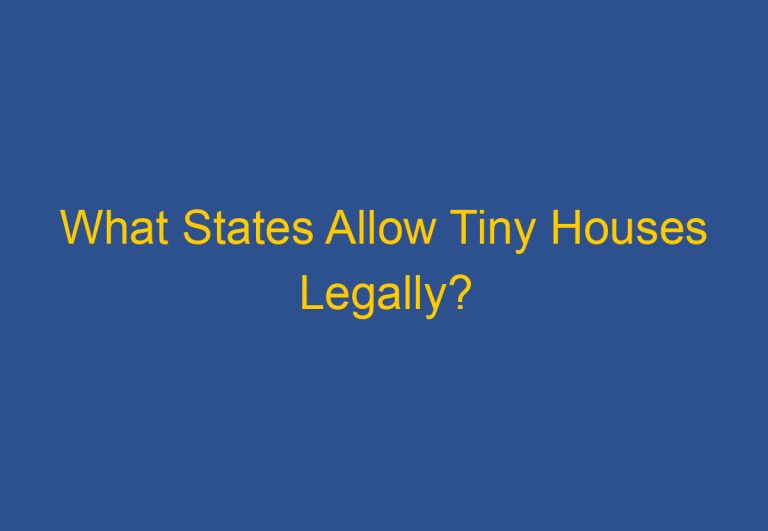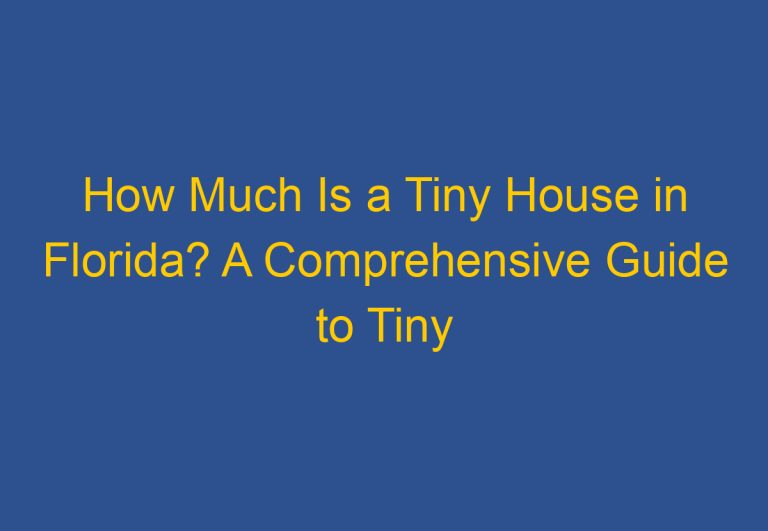Can I Build a Tiny House in Ohio? A Guide to Ohio’s Tiny House Regulations
If you’re considering building a tiny house in Ohio, you’re likely wondering about the rules and regulations surrounding this type of dwelling. While tiny homes have grown in popularity across the country, the laws governing their construction and placement can vary widely from state to state and even from city to city. In Ohio, there are specific guidelines that you’ll need to follow if you want to build a tiny house.

First and foremost, it’s important to note that tiny houses are legal in certain counties in Ohio, including Cuyahoga and Preble. However, each county has its own set of guidelines for tiny house construction and parking, so it’s crucial to check with the specific county’s zoning laws before you build or park a tiny house. Some counties in Ohio consider a house covering an area of 500 square feet or less to be a tiny house, while others have different size requirements.
The cost of building a tiny house in Ohio can also vary greatly depending on factors such as the size, design, materials used, and desired amenities. Plan to spend between $40,000 – $130,000. However, to establish an accurate budget based on your specific requirements, it’s best to consult with professionals or builders. With that said, building a tiny house in Ohio can be an exciting and rewarding project, and with the right knowledge and preparation, you can create a comfortable and functional living space that meets your needs and fits within the legal guidelines.
Understanding Ohio’s Tiny House Regulations

When it comes to building a tiny house in Ohio, there are several regulations and guidelines that must be followed. Understanding these regulations is crucial to ensure that your tiny house is legal and safe to live in. In this section, we will explore the zoning laws and building codes in Ohio, the differences in county regulations, and the certifications and standards for tiny homes.
Zoning Laws and Building Codes
The Ohio building code states that the minimum size of a dwelling unit should be 950 square feet, which is much larger compared to the typical tiny house dimensions prevalent all over the United States. However, tiny houses are not explicitly outlawed in Ohio. Instead, they are subject to local zoning regulations and building codes.
Local zoning regulations dictate where a tiny house can be parked or built. For instance, Cuyahoga County, Ohio, and Preble County, Ohio, allow tiny houses with specific guidelines. However, regulations and restrictions vary by location, so it is essential to check with the specific county’s zoning laws before building or parking a tiny house.
The International Residential Code (IRC) also provides guidelines for building tiny homes. These guidelines cover everything from the minimum size of a dwelling unit to the requirements for plumbing, heating, and electrical systems. If you plan to build a tiny house in Ohio, you must follow the IRC guidelines to ensure that your home is safe and up to code.
Differences in County Regulations
Each county in Ohio has its own set of guidelines for tiny house construction and parking. For instance, Cuyahoga County requires that tiny houses be on a foundation and connected to utilities like water and electricity. They also require that the tiny house be inspected by a certified inspector before it can be occupied.
Preble County, on the other hand, allows tiny houses on wheels, but they must be parked on a lot that has a primary dwelling unit. They also require that the tiny house be connected to utilities like water and electricity and have a septic system.
Certifications and Standards for Tiny Homes
There are several certifications and standards that tiny homes can adhere to, such as the National Organization of Alternative Housing (NOAH) certification, the Recreational Vehicle Industry Association (RVIA) certification, and the Underwriters Laboratories (UL) certification. These certifications ensure that the tiny home meets certain safety and quality standards.
It is essential to note that not all certifications are recognized in every state. Therefore, you must research which certifications are recognized in Ohio before building a tiny house.
In conclusion, building a tiny house in Ohio requires adherence to local zoning regulations and building codes. Understanding these regulations is crucial to ensure that your tiny house is legal and safe to live in. By following the guidelines provided by the IRC and obtaining the necessary certifications, you can build a tiny house that is up to code and meets safety standards.
Planning and Building Your Tiny House in Ohio

Building a tiny house in Ohio requires careful planning and adherence to local regulations. This section will provide an overview of the key considerations when planning and building your tiny house in Ohio.
Selecting a Location and Foundation
When selecting a location for your tiny house, it’s important to consider local zoning regulations. Certain counties in Ohio allow tiny houses, while others do not. Additionally, you’ll need to consider the type of foundation you want to use. Some options include a traditional concrete foundation, a pier and beam foundation, or a trailer foundation. Each option has its own advantages and disadvantages, and your choice will depend on your specific needs and budget.
Designing for Comfort and Compliance
When designing your tiny house, it’s important to consider both comfort and compliance. You’ll need to ensure that your tiny house meets local building codes and regulations, including those related to structural integrity, insulation, electrical systems, and plumbing systems. Additionally, you’ll want to design your tiny house to be comfortable and livable, with features like stairs, storage solutions, and a functional kitchen and bathroom.
Navigating Financing and Insurance
Financing and insurance can be challenging for tiny house builders, as many traditional lenders and insurers are hesitant to work with tiny houses. However, there are some financing options available, including personal loans and RV loans. Additionally, there are specialized insurance providers that offer coverage for tiny houses. It’s important to do your research and find a lender and insurer that understands the unique needs of tiny house homeowners.
Overall, building a tiny house in Ohio requires careful planning, quality craftsmanship, and a commitment to compliance with local regulations. By selecting the right location and foundation, designing for comfort and compliance, and navigating financing and insurance, you can build a beautiful and functional tiny house that meets your needs and budget.
Frequently Asked Questions

What are the zoning regulations for tiny houses in Ohio?
Zoning regulations for tiny houses in Ohio vary depending on the county. Some counties, such as Cuyahoga and Preble, allow tiny houses, while others may have restrictions or prohibit them altogether. It is important to check with the specific county’s zoning laws before building or parking a tiny house. Each county has its own set of guidelines for tiny house construction and parking.
Are there specific permits required for constructing a tiny house in Ohio?
The permits required for constructing a tiny house in Ohio depend on the county and the type of structure being built. Some counties may require building permits, while others may not. It is important to check with the specific county’s zoning laws and building codes before beginning construction of a tiny house.
How do tiny house communities in Ohio operate?
Tiny house communities in Ohio operate similarly to other housing communities. Residents typically own or rent their tiny homes and share common spaces, such as laundry facilities and outdoor areas. Some communities may have additional amenities, such as community gardens or recreational facilities. It is important to research and visit different communities to find one that meets your needs and preferences.
What is the minimum square footage required for a house in Ohio?
The Ohio building code requires a minimum size of 950 square feet for a house, which is larger than the typical dimensions of a tiny house. However, some counties may have different regulations or exemptions for tiny houses. It is important to check with the specific county’s zoning laws and building codes before building a tiny house in Ohio.
What is the average cost to build a tiny home in Ohio?
The cost of building a tiny house in Ohio can vary greatly depending on factors such as the size, design, materials used, and desired amenities. Plan to spend between $40,000 – $130,000. It is important to research different builders and suppliers to find the best options for your budget and needs.
Are there any counties in Ohio known for being particularly tiny house friendly?
Cuyahoga and Preble counties are known for being particularly tiny house friendly, with regulations and restrictions that allow for the construction and parking of tiny homes. However, it is important to check with the specific county’s zoning laws before building or parking a tiny house.






